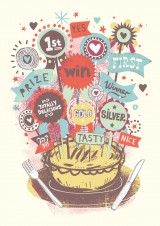 |
| example of Ruscha's work. |
These examples were inspired by an artist called Ed Ruscha creating typography. The artist looks like he then goes and digitally enhances the images on photoshop. I then decided to have a go myself using food materials such as salt,sugar,spaghetti,beans,ketchup and pasta. I found it really easy working with the material like ketchup and salt, and it is easy to get it in the exact place you want it, other material like pasta, as it is hard, it is a bit more difficult to create the exact you may have wanted for instance, small floaty text, in the end, we chose quite a standard font to use. Whilst thinking about the text we always made sure that our typography always related back to our material such as using ketchup, we wrote out the word splat!
I really enjoyed working this way as I have always preferred handmade as you have more more control on the outcome. To go back and develop this further I would take this original images and then edit them into Photoshop to give a more sleek effect looking much more like Ed Ruscha's work.
.JPG)
.JPG)
.JPG)
.JPG)
.JPG)
.JPG)
.JPG)
.JPG)
.JPG)

















